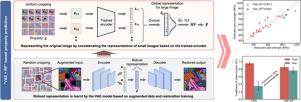利用深度学习分解强化机制,将微观结构映射到力学性能
IF 9.3
1区 材料科学
Q1 MATERIALS SCIENCE, MULTIDISCIPLINARY
引用次数: 0
摘要
材料微观结构中的物理编码对于预测力学性能至关重要。然而,由于微观结构和替代模型的复杂性,使用深度学习解纠缠或表示这些信息仍然是一个长期存在的挑战。在这里,我们提出了一种包括图像增强、自监督学习和回归的方法来实现可解释表示和改进的预测模型。我们在不同测量的微观结构和屈服强度的小数据集上演示了提出的策略。学习表征(潜变量)与屈服强度呈Hall-Petch关系,表明捕获了细晶粒强化机制。结果表明,应用于测试数据时,目标属性的模型精度提高了一倍。我们的方法可以推广到其他场景,以识别将微观结构与有限数据可用的属性相关联的关键物理。本文章由计算机程序翻译,如有差异,请以英文原文为准。

Mapping microstructure to mechanical property by disentangling strengthening mechanism with deep learning
The physics encoded in materials microstructures are essential to predict mechanical properties. However, disentangling or representing such information using deep learning remains a long-standing challenge due to the complexity in both microstructures and surrogate models. Here, we present an approach that comprises image augmentation, self-supervised learning and regression to achieve interpretable representation and improved prediction model. We demonstrate the proposed strategy on a small dataset of diverse measured microstructures and yield strengths. The learned representation (latent variables) shows a Hall–Petch like relationship with yield strength, indicating the capture of fine grain strengthening mechanism. As a result, the model accuracy for target property is doubled when applying to test data. Our approach can be generalized to other scenarios to recognize key physics for correlating microstructures to properties where limited data is available.
求助全文
通过发布文献求助,成功后即可免费获取论文全文。
去求助
来源期刊

Acta Materialia
工程技术-材料科学:综合
CiteScore
16.10
自引率
8.50%
发文量
801
审稿时长
53 days
期刊介绍:
Acta Materialia serves as a platform for publishing full-length, original papers and commissioned overviews that contribute to a profound understanding of the correlation between the processing, structure, and properties of inorganic materials. The journal seeks papers with high impact potential or those that significantly propel the field forward. The scope includes the atomic and molecular arrangements, chemical and electronic structures, and microstructure of materials, focusing on their mechanical or functional behavior across all length scales, including nanostructures.
 求助内容:
求助内容: 应助结果提醒方式:
应助结果提醒方式:


